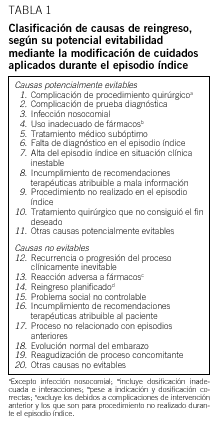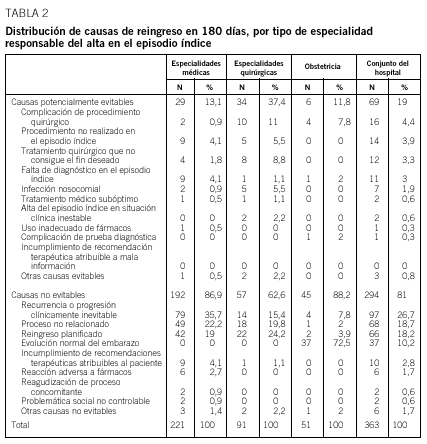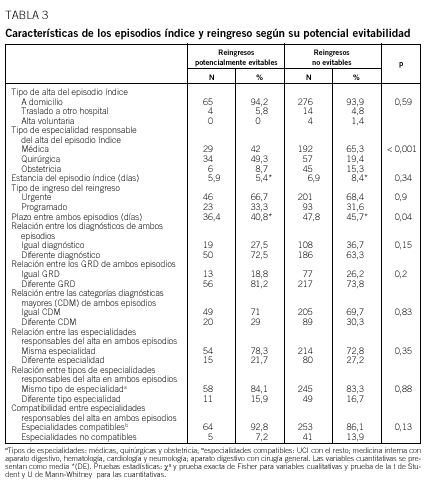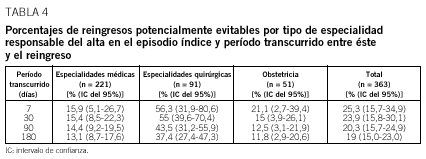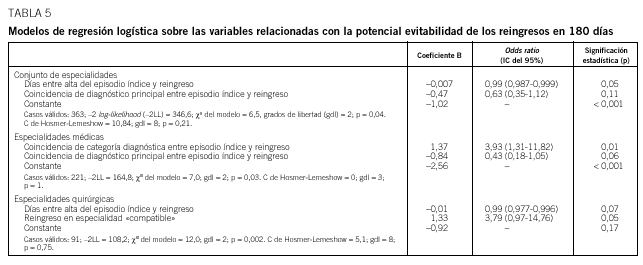Journal Information
Vol. 118. Issue 13.
Pages 500-505 (April 2002)
Vol. 118. Issue 13.
Pages 500-505 (April 2002)
Análisis de las causas de los reingresos en un hospital de agudos y su evitabilidad potencial
Analysis of the causes and potential avoidability of readmissions in an acute patients' hospital
Visits
5261
Alberto Jiménez-Puentea, Javier García-Alegríab, Jorge Gómez-Aracenac, Luis Hidalgo-Rojasb, Luisa Lorenzo-Nogueirasa, Joaquín Fernández-Crehuet-Navajasa
a Direccción de sistemas de Información. Hospital Costa del Sol. Departamento de Medicina Preventiva y Salud Pública. Facultad de Medicina. Málaga.
b Área de Medicina. Hospital Costa del Sol. Departamento de Medicina Preventiva y Salud Pública. Facultad de Medicina. Málaga.
c Unidad de Medicina Preventiva. Hospital Costa del Sol. Departamento de Medicina Preventiva y Salud Pública. Facultad de Medicina. Málaga.
This item has received
Article information
Fundamento: Las tasas de reingresos hospitalarios se utilizan como indicadores de calidad asistencial, aunque las causas de éstos no están suficientemente estudiadas ni existe una definición unificada del indicador. Nos planteamos determinar las causas y potencial evitabilidad de los reingresos en nuestro centro e identificar su definición más adecuada. Pacientes y métodos: Estudio observacional transversal. Ámbito: Hospital Costa del Sol (Marbella, Málaga). Sujetos de estudio: muestra aleatoria de reingresos en 6 meses del alta (n = 363). Instrumentalización: determinación de las causas y potencial evitabilidad de los reingresos mediante revisión de historias clínicas por pares de observadores. Análisis descriptivo y de regresión logística sobre las variables del Conjunto Mínimo Básico de Datos (CMBD) que se relacionan con la evitabilidad de los reingresos. Resultados: El 19% (intervalo de confianza [IC] del 95%, 15,0-23,0) de los reingresos hospitalarios en 6 meses del alta se atribuyeron a situaciones potencialmente evitables de haberse modificado los cuidados aplicados durante el episodio previo. Este porcentaje alcanzó el 37% (IC del 95%, 27,4-47,3) para servicios quirúrgicos, el 13% (IC del 95%, 8,7-17,6) para servicios médicos y el 12% (IC del 95%, 2,9-20,6) para obstetricia. Las variables relacionadas con la potencial evitabilidad de los reingresos fueron, en el conjunto del hospital, la menor duración del plazo desde el alta previa y la diferencia de diagnóstico entre ambos episodios. Conclusiones: La mayor parte de los reingresos hospitalarios se deben a situaciones no evitables mediante la modificación de los cuidados aplicados durante el ingreso previo. Las definiciones de tasas de reingresos deberían incluir solamente los reingresos tempranos y con un diagnóstico principal diferente al del ingreso previo, con el fin de detectar fundamentalmente situaciones potencialmente evitables.
Palabras clave:
Reingresos hospitalarios
Resultados clínicos
Calidad asistencial
Background: Rates of hospital readmissions are used as indicators of quality of health care. Yet specific causes of readmissions have not been sufficiently studied and an unified definition of such an indicator is lacking. Our goal was to determine the causes and potential avoidability of readmissions in our hospital and to identify a suitable definition of this indicator. Patients and method: Design: Cross sectional study. Setting: Hospital Costa del Sol (Marbella, Málaga). Subjects of study: Random sample of hospital discharges followed by a new admission within the next 6 months (n = 363). Interventions: Determination of the causes and potential avoidability of readmissions, by means of a peer-review of medical records. Descriptive and logistic regression analysis of the variables contained in the Minimum Basic Data Set (MBDS) and related to the avoidability of readmissions. Results: 19% (95% CI: 15.0-23.0) of hospital readmissions within 6 months after hospital discharge were attributed to potentially avoidable situations if the applied medical care had been modified during the previous episode. This figure reached 37% (95% CI: 27.4-47.3) for surgical services, 13% (95% CI: 8.7-17.6) for medical services and 12% (95% CI: 2.9-20.6) for obstetrics. The MBDS variables related to the potential avoidability of readmissions were, for the whole hospital, 1) the shorter interval from the previous discharge and 2) the difference of diagnosis between both episodes. Conclusions: Most hospital readmissions are due to non-avoidable situations if the applied medical care had been modified during the previous episode. In order to detect potentially avoidable situations, definitions of readmission rates should only include early readmissions with a chief diagnosis other than that in the previous admission.
Keywords:
Hospital readmissions
Clinical outcomes
Quality of health care
These are the options to access the full texts of the publication Medicina Clínica
Subscriber
Subscribe
Purchase
Contact
Phone for subscriptions and reporting of errors
From Monday to Friday from 9 a.m. to 6 p.m. (GMT + 1) except for the months of July and August which will be from 9 a.m. to 3 p.m.
Calls from Spain
932 415 960
Calls from outside Spain
+34 932 415 960
E-mail






